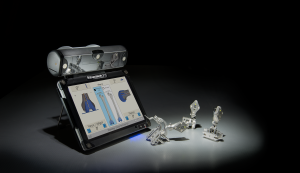Navigation, or computer-assisted surgery, has been around for many years. Many of us have had experience with at least one of the major systems on the market. Most recently, I have been using ExactechGPS® for my primary TKA procedures. Personally, I have had great success with the system and believe that my patients have benefited accordingly. So when Exactech asked me to be a part of the team to design their new revision knee system, Optetrak Logic® CC, and they informed me that it included an opportunity to develop the first-of-its-kind application to use the ExactechGPS system for revision procedures (rTKA), I was intrigued and ultimately decided to accept the opportunity.

In my career as an orthopedic surgeon, I have performed 750 revision TKAs using most of the major revision knee systems on the market. The majority of these systems had room for improvement. I knew there was an opportunity to create a state-of-the-art system that uses computer-assisted surgery to achieve optimal outcomes in the revision setting. Before I began to think through inputs on how the revision platform for ExactechGPS could be beneficial to surgeons and patients, I knew that it would be helpful to review data on how computer-assisted surgery is being used in the primary knee setting.
During this journey, I realized that most orthopedic surgeons use computer-assisted surgery to achieve better alignment, to be faster in the O.R., to have an overall reduction in instrumentation, to avoid violating the IM canal and be able to access pre and post-op kinematics. For the most part, the majority of these are achieved through the use of computer-assisted surgery in TKA. In fact, one of the most compelling pieces of literature I discovered came out of the 2013 Australian Orthopaedic Association National Joint Replacement Registry. These data showed that when using navigation, there was a 20 percent reduction in the revision burden in patients 65 years of age and younger.1 Additionally, the research highlighted that in cases where aseptic rTKA was necessary, the primary cause was mechanical loosening of the prosthetic joint (American Joint Replacement Registry & California Joint Replacement Registry 2014).2 Another study “The Epidemiology of Revision Total Knee Arthroplasty in the United States” found that out of 60,355 knees, 16 percent failed due to mechanical loosening.3 Adding to the issue of loosening, Sharkey et al. determined that 55.6 percent of revisions were performed less than two years after the initial operation.4 These data led me to believe there is a clinical need for computer-assisted surgery in the revision setting. What remains to be seen is if the use of navigation will consistently yield better patient-reported outcomes in the revision setting. Our hypothesis is that we will see improvements in rTKA, based on the success of navigation in the primary setting.
With the conclusion that computer-assisted surgery for rTKA was something we wanted to continue developing, we discussed features and benefits required to: 1) assist with adoption of the technology and 2) to offer an improvement in how revision procedures are performed. We decided to focus on three key goals: 1) increasing the number of orthopedic surgeons performing rTKA procedures, 2) making rTKA procedures easier and more reproducible, and 3) collecting data to see if the use of navigation in the revision setting will yield clinical benefits. Because the number of revision knees in the United States is expected to increase, it was important to the team that the ExactechGPS revision application make it easier for surgeons to perform rTKA procedures without years of revision experience. This goal has been achieved by developing a system that conducts acquisitions from the previously implanted primary knee components, which allows us as surgeons to easily document why it was sub-optimal. A key feature of the revision application is the ability for the surgeon to align with either the mechanical or anatomical axis to produce the desired alignment. Overall, I believe the ExactechGPS revision platform should make revisions easier and more efficient with improved functional outcomes. •
REFERENCES
- Australian Orthopaedic Association, National Joint Replacement Registry, Annual Report 2013 – Hip and Knee Arthroplasty.
- American Joint Replacement Registry and California Joint Replacement Registry, Annual Report 2014
- Bozic KJ, Kurtz SM, Lau E, Ong K, Chiu V, Vail TP, Rubash HE, Berry DJ. The epidemiology of revision total knee arthroplasty in the United States. Clin Orthop Relat Res. 2010 Jan;468(1):45-51. doi: 10.1007/s11999-009-0945-0. Epub 2009 Jun 25.
- Sharkey PF, Hozack WJ, Rothman RH, Shastris, Jacoby SM. Insall Award paper. Why are total knees failing today? Clin Orthop Relat Res. 2002 Nov;(404):7-13.
